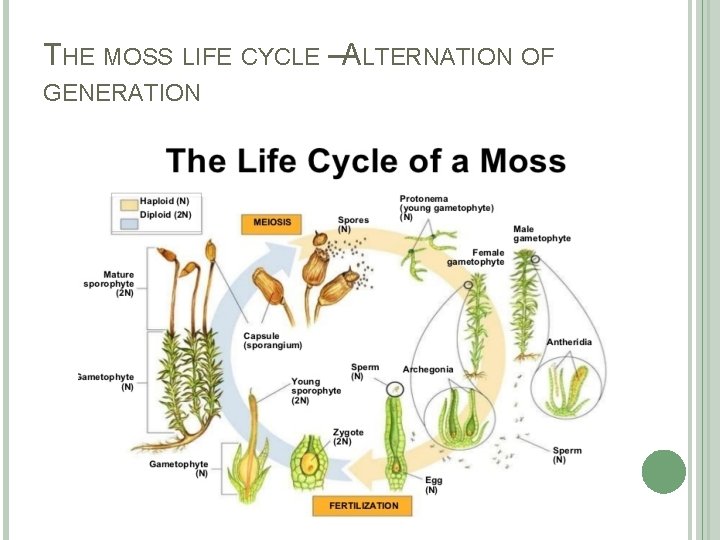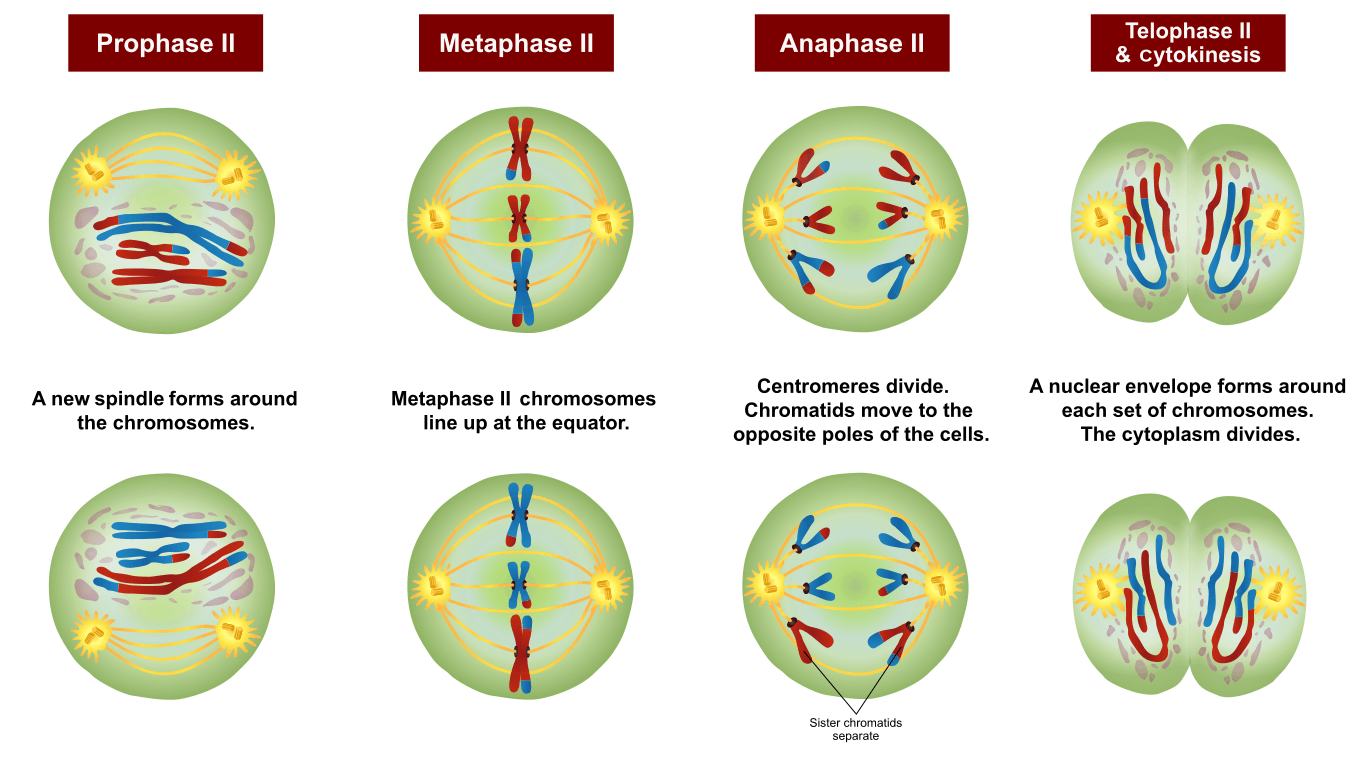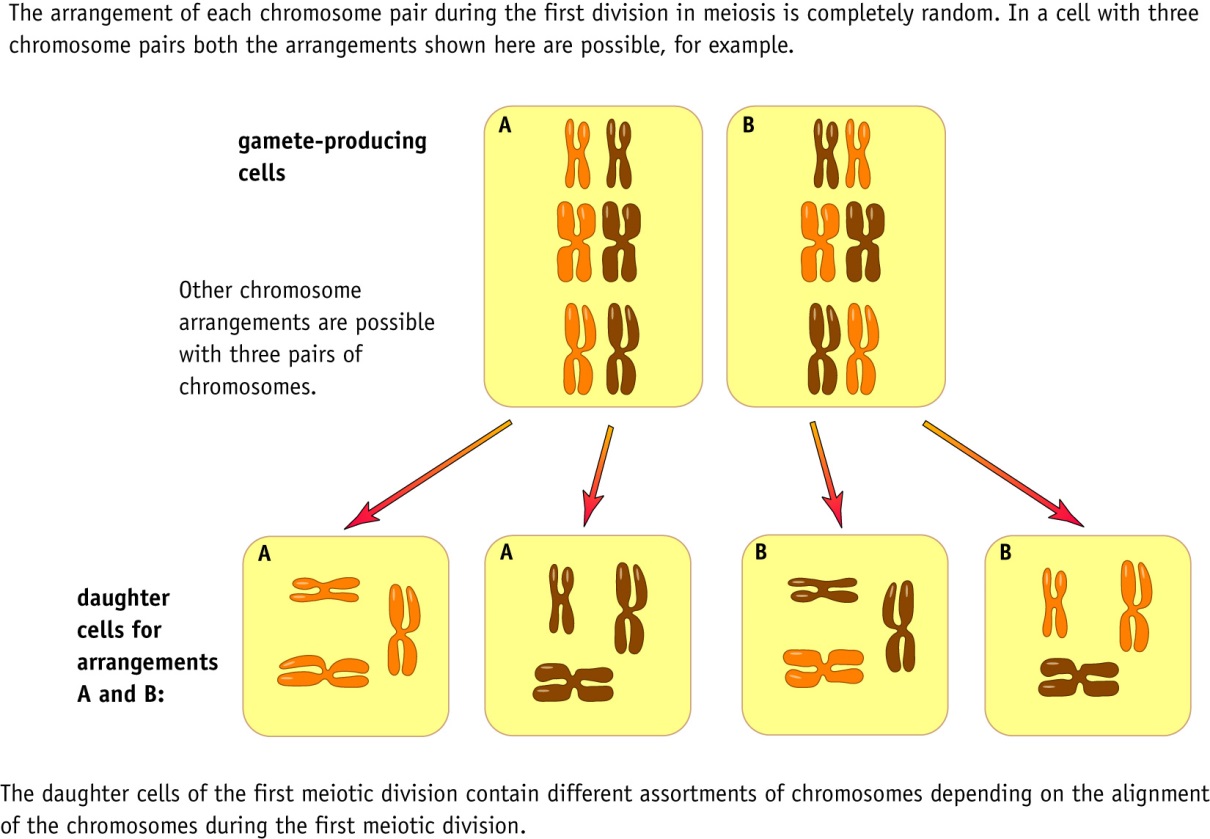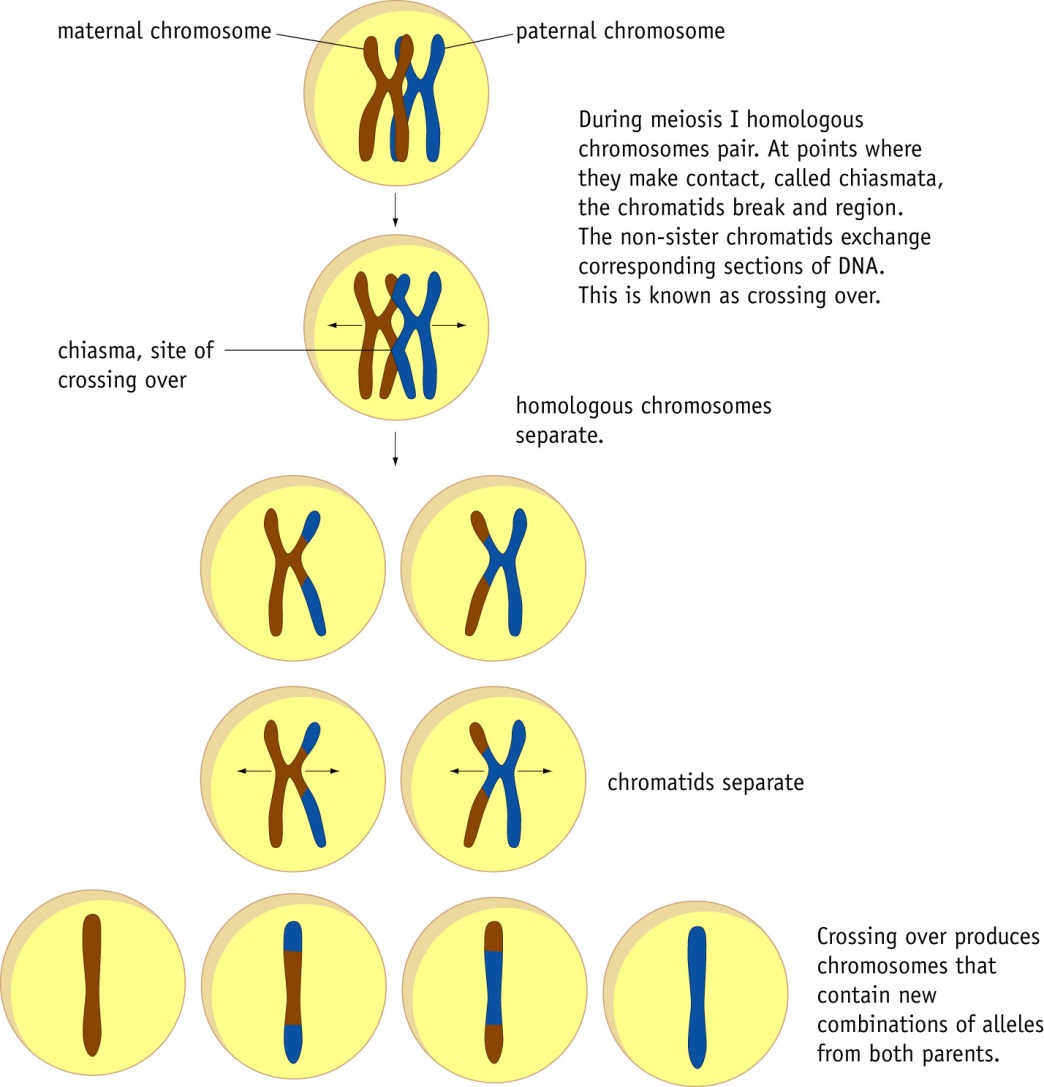2.1.6 Meiosis
2.1.6 Cell division, cell diversity and cellular organisation (f-g)
Meiosis - Notes
2.1.6f: the significance of meiosis in life cycles
Define the terms “diploid”, “haploid”, “gamete”, “zygote”, “meiosis”, and “reduction division”. (F)
Explain the role of meiosis in life cycles.
Describe the alternation of generations in plants, the different life cycles of the different types of plant (bryophytes, ferns, conifers and flowering plants), and explain why meiosis doesn’t just produce gametes (as its role is often simplified to). (S+C).
State 2 ways in which meiosis produces variation. (F)
Suggest the importance of the creation of different allele combinations in populations.
2.1.6g: the main stages of meiosis
Define the terms “homologous chromosomes”, “bivalent”, “crossing over”, “chiasma” (chiasmata is plural), “recombinant chromatid” and “random independent assortment”. (F)
Draw, label and annotate a summary diagram of meiosis simplified to a single homologous pair (without any crossing over). (F)
State the stages of meiosis in order.
Draw, label and annotate a sequence of diagrams to show the stages of meiosis and what occurs at each stage. (F)
Identify the stage of meiosis a cell is in from diagrams and photos of cells.
Describe the process of crossing over and explain how it produces genetic variation. (F)
Describe the process of random independent assortment and explain how it produces genetic variation. (F)
Explain (given the chromosome number of the species) how to calculate the total number of possible genetically different gametes that could be produced through independent assortment only.
Draw a table to compare meiosis I, meiosis II and mitosis.
Draw a table to compare mitosis and meiosis. (F)
The purpose of meiosis
Meiotic cell division is a reduction division – it reduces the number of copies of each chromosome in the daughter cells compared to the parent cell.
In most cases meiosis makes haploid cells with one of copy of each chromosome (n) from diploid cells with two copies of each chromosome (2n).
The reason it is important to produce haploid cells at some point in the life cycle of a sexually reproducing organism is that fertilisation involves two cells but the cell produced at fertilisation (the zygote) needs to be diploid. Meiosis means that the diploid number of chromosomes can be restored at fertilisation if the two cells doing the fertilising (the gametes) are haploid.
Gametes are the specialised cells that undergo the fertilisation process when they meet. In some organisms, such as animals, haploid gametes are produced directly from meiosis. However, in other organisms, such as moss, meiosis occurs at a different stage in the cell cycle. The haploid cells produced directly from meiosis go through many mitotic cell divisions before some of the haploid cells differentiate into gametes.

As well as ensuring the diploid number of chromosomes is restored at fertilisation another role of meiosis is to produce genetic variation.
Only mutation (not a planned part of meiotic cell division) can produce new alleles. However, meiosis can produce different combinations of alleles of different genes in each daughter cell.
Having plenty of genetic variation within a population helps populations to survive changes in their environment. For example, if a new pathogen arrives, it is more likely that at least some of the population will be resistant to it and survive whilst the others get killed by the pathogen. This is natural selection in action.
Conversely, if there is very little genetic variation in a population there may not be any individuals that can survive the change in the environment and so the population will go extinct rather than be able to evolve to cope with the change.
Meiosis
Meiosis is another type of nuclear division. Instead of producing identical cells to the parent like mitosis, meiosis produces cells with half the number of chromosomes as the parent cell. They are called haploid because these new cells only have one copy of each chromosome (as opposed to diploid which is two copies of each chromosome. i.e. chromosomes are in homologous pairs).
In meiosis the DNA is replicated and then the cell undergoes 2 separate divisions called Meiosis I and Meiosis II.
Interphase of Meiosis I is the same as interphase in mitosis.
In Prophase I, homologous chromosomes (chromosomes that are part of the same pair) pair up to form a bivalent and a process called crossing over occurs. Apart from that all the other events of Prophase I are the same as the events in Prophase of mitosis.
In Metaphase I, the bivalents line up on the equator of the cell and attach to the spindle fibres at their centromeres.
In Anaphase I the bivalents separate into their homologous chromosomes, one chromosome from each bivalent travelling to each pole of the cell.
In Telophase I the same events happen as in Telophase of mitosis (although sometimes the chromosomes hardly unravel at all).
The first cell division then takes place (this is a reduction division – going from 2n(x2) to n(x2)).
In Meiosis II there may be a short interphase or the cells may go straight into Prophase II.
In Prophase II any unravelling of the chromosomes that occurred in Telophase I is reversed, and the other usual events of Prophase occur (there is no crossing over here, only in Prophase I).
In Metaphase II chromosomes line up on the equator of the cell and attach to the spindle by their centromeres.
In Anaphase II the chromosomes separate into their sister chromatids, one chromatid from each bivalent travelling to each pole of the cell.
In Telophase II the same events happen as in Telophase of mitosis.
The second cell division then takes place (not a reduction division as it is going from n(x2) to n).
Meiosis produces 4 daughter cells from one parent cell and they are genetically different from each other and from the parent cell.


Image Source: Wikipedia (Ali Zifan).
How meiosis generates genetic variation
Meiosis generates different combinations of alleles by:
crossing-over in Prophase I (to make different combinations of alleles on chromosomes)
independent assortment of chromosomes in Metaphase I (to make different combinations of chromosomes in each cell)
independent assortment chromatids in Metaphase II (to make different combinations of chromosome in each cell)
Independent assortment (sometimes called ‘random independent assortment’) is the term used to describe the fact that when bivalents line up in Meiosis I they have equal chance of lining up in a way that would make a particular chromosome go to one pole of the cell or the other. This means that each group of chromosomes at either pole will have some that originally came from the mother and some that came from the father.
Because crossing over leads to sister chromatids that are not genetically identical anymore independent assortment also occurs when chromosomes separate into chromatids in Meiosis II.
Because different cells undergoing meiosis randomly line up their chromosomes in different orientations the gametes produced from one cell are different to the gametes produced from another cell.

Note: Independent assortment describes the lining up of bivalents in Metaphase I and chromosomes in Metaphase II. Sometimes the term ‘independent separation’ is used and this refers to what is happening in Anaphase I and Anaphase II.
The amount of genetic variation that independent assortment can produce (even without crossing over) is staggering.
The number of different gametes that could be produced is 2 to the power of ‘the haploid number of chromosomes’.
Crossing-over is the term used to describe the process where homologous chromosomes swap parts of their length during Prophase I.
When homologous chromosomes join together to form bivalents parts of one chromatid from each chromosome wrap around each other to form structures called chiasmata (singular: chiasma). The non-sister chromatids break at these chiasmata and swap equivalent lengths of DNA. The fragments being swapped join to the other chromatid to make complete chromatids again. These newly formed chromatids are called ‘recombinant chromatids’.
Without crossing over sister chromatids are genetically identical and so there are only two varieties of each type of chromosome in diploid cells. Crossing over leads to all 4 chromatids having different combinations of alleles on them. This means that the 4 daughter cells produced from meiosis will be more genetically different to each other than with independent assortment alone.
On top of this crossing over occurs in random positions along chromosomes each time meiosis occurs so each parent cell undergoing meiosis forms chiasmata in different places and ends up with different combinations of alleles in the gametes it forms, compared to the gametes formed from other parent cells.

Identifying cells in the stages of meiosis
When looking at cells (or diagrams of cells) to determine whether they are in mitosis or meiosis and which stage they are in you need to know what’s happening in each stage of the process and pay particular attention to the number of chromosomes present and whether homologous pairs have joined together to form bivalents.
The table below compares what each stage would look like if the parent diploid cell had 6 chromosomes (3 pairs of chromosomes)
Stage | Meiosis I | Meiosis II | Mitosis |
Prophase | 3 Bivalents starting to appear as the chromosomes condense | 3 chromosomes starting to appear as chromosomes condense | 6 chromosomes starting to appear as chromosomes condense |
Metaphase | 3 Bivalents line up on the equator of the cell | 3 chromosomes line up on the equator of the cell | 6 chromosomes line up on the equator of the cell |
Anaphase | 3 chromosomes moving to each pole of the cell | 3 chromatids moving to each pole of the cell | 6 chromatids moving to each pole of the cell |
Telophase | 3 chromosomes at each pole of the cell | 3 chromatids at each pole of the cell | 6 chromatids at each pole of the cell |
Comparing mitosis and meiosis
The table below compares meiosis I, meiosis II and mitosis.
Feature | Meiosis I | Meiosis II | Mitosis |
DNA is replicated | Y | N | Y |
Homologous chromosomes pair up into bivalents | Y | N (there’s only one of each type of chromosome in each cell) | N (they are present but they don’t pair up) |
Bivalents separate into chromosomes | Y | N | N |
Chromosomes separate into chromatids | N | Y | Y |
Crossing over occurs | Y | N | N |
Independent assortment occurs | Y | Y | N |
The table below compares the whole process of meiotic cell division with mitotic cell division
Feature | Meiosis | Mitosis |
Number of cell divisions | 2 | 1 |
Number of cells produced | 4 | 2 |
Homologous chromosomes present | Y | Y if diploid N if haploid |
Homologous chromosomes join up into bivalents | Y | N |
Comparison of the daughter cells to the parent cell | Haploid and all genetically different | Diploid and both genetically identical to each other and to the original cell (or haploid if the original cell is haploid) |
Crossing over occurs | Y | N |
Independent assortment occurs | Y | N |
Genetically identical cells produced | N | Y |